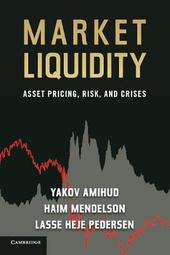
|
Market Liquidity: Asset Pricing, Risk, and Crises
Paperback / softback
Main Details
| Title |
Market Liquidity: Asset Pricing, Risk, and Crises
|
| Authors and Contributors |
By (author) Yakov Amihud
|
|
By (author) Haim Mendelson
|
|
By (author) Lasse Heje Pedersen
|
| Physical Properties |
| Format:Paperback / softback | | Pages:292 | | Dimensions(mm): Height 229,Width 17 |
|
| Category/Genre | Investment and securities |
|---|
| ISBN/Barcode |
9780521139656
|
| Classifications | Dewey:332.6 |
|---|
| Audience | | Professional & Vocational | |
|---|
| Illustrations |
27 Tables, unspecified; 1 Halftones, unspecified; 31 Line drawings, unspecified
|
|
Publishing Details |
| Publisher |
Cambridge University Press
|
| Imprint |
Cambridge University Press
|
| Publication Date |
12 November 2012 |
| Publication Country |
United Kingdom
|
Description
This book presents the theory and evidence on the effect of market liquidity and liquidity risk on asset prices and on overall securities market performance. Illiquidity means incurring a high transaction cost, which includes a large price impact when trading and facing a long time to unload a large position. Liquidity risk is higher if a security becomes more illiquid when it needs to be traded in the future, which will raise trading cost. The book shows that higher illiquidity and greater liquidity risk reduce securities prices and raise the expected return that investors require as compensation. Aggregate market liquidity is linked to funding liquidity, which affects the provision of liquidity services. When these become constrained, there is a liquidity crisis which leads to downward price and liquidity spiral. Overall, the volume demonstrates the important role of liquidity in asset pricing.
Author Biography
Yakov Amihud is the Ira Rennert Professor of Finance at the Stern School of Business, New York University. His published research focuses on the effects of the liquidity of stocks and bonds on their returns and values and the design and evaluation of securities markets' trading methods and systems. On these topics, Professor Amihud has advised the New York Stock Exchange, American Stock Exchange, Chicago Board of Options Exchange, Chicago Board of Trade and other securities markets. He has published more than ninety research articles in professional journals and in books and edited and co-edited five books on securities market design, international finance, leveraged buyouts and bank mergers and acquisitions. Haim Mendelson is the Kleiner Perkins Caufield and Byers Professor of Electronic Business and Commerce and Management, at the Graduate School of Business, Stanford University. His research interests include securities markets, electronic markets, information technology and the information industries. He was elected Distinguished Fellow of the Information Systems Society in recognition of outstanding intellectual contributions to the discipline. Professor Mendelson has published more than one hundred research papers in professional journals and has consulted for high-tech companies, financial institutions and securities markets. Lasse Heje Pedersen is the John A. Paulson Professor of Finance and Alternative Investments at the New York University Stern School of Business and a principal at AQR Capital Management. He has been part of the Liquidity Working Group of the Federal Reserve Bank of New York, the New York Fed's Monetary Policy Panel, the Board of Directors of the American Finance Association, the Economic Advisory Boards of NASDAQ and FTSE, and associate editor at the Journal of Finance, the Journal of Economic Theory, Review of Asset Pricing Studies, and the Quarterly Journal of Economics. His research explains how crises can arise from liquidity spirals and how market and funding liquidity risks explain equity returns, bond yields, option prices, and currency crashes. Professor Pedersen received the 2011 Bernacer Prize for the best European economist under the age of 40 in macroeconomics and finance.
Reviews'These authors were writing and teaching about the importance of understanding liquidity way before we all learned more about it than we cared to. They have made major contributions to understanding the real, not purely theoretical, world that investors face every day. Gathering their seminal work in one place along with updated perspectives and overviews is a serious contribution.' Cliff Asness, AQR Capital Management 'Over the past quarter century, the research contributions of Amihud, Mendelson, and Pedersen have been central to an understanding of the determinants and pricing of market liquidity and liquidity risk. This collection places the best available work on the topic between two covers. It must be read by anyone following this subject area.' Darrell Duffie, Stanford University 'The liquidity of financial markets has never been a more important topic of research and policy and this book gives a very accessible way to understand both the traditional and current research. The book reproduces eight papers that range from the seminal work that defined the field starting in the 1980s to the recent research based on the analysis of the financial crisis. A particular feature of the book is the series of extended introductions to each of the papers, written nontechnically to summarize each paper and how it fits into future research - they will transport you to a first rate graduate classroom.' Robert Engle, Nobel Laureate and Director, Volatility Institute, New York University 'The term 'market liquidity' means different things to different people at different times. Distinguishing, defining, and measuring the different meanings is an important activity, especially now, after four years of financial crises. This collection of scientific papers by eminent scholars is an important contribution to understanding market frictions and arrangements to manage them.' Thomas Sargent, Nobel Laureate, New York University 'The authors have made substantial contributions in microstructure, and especially in the understanding of liquidity, for years. This collection of their best articles on liquidity is particularly timely given the growing realization of the macro pathology caused by a financial-crisis-induced recession. They present strong evidence that a liquidity spiral hurts post-recession real investment.' David Whitcomb, author of Securities Market Microstructure and Founder, Automated Trading Desk
|